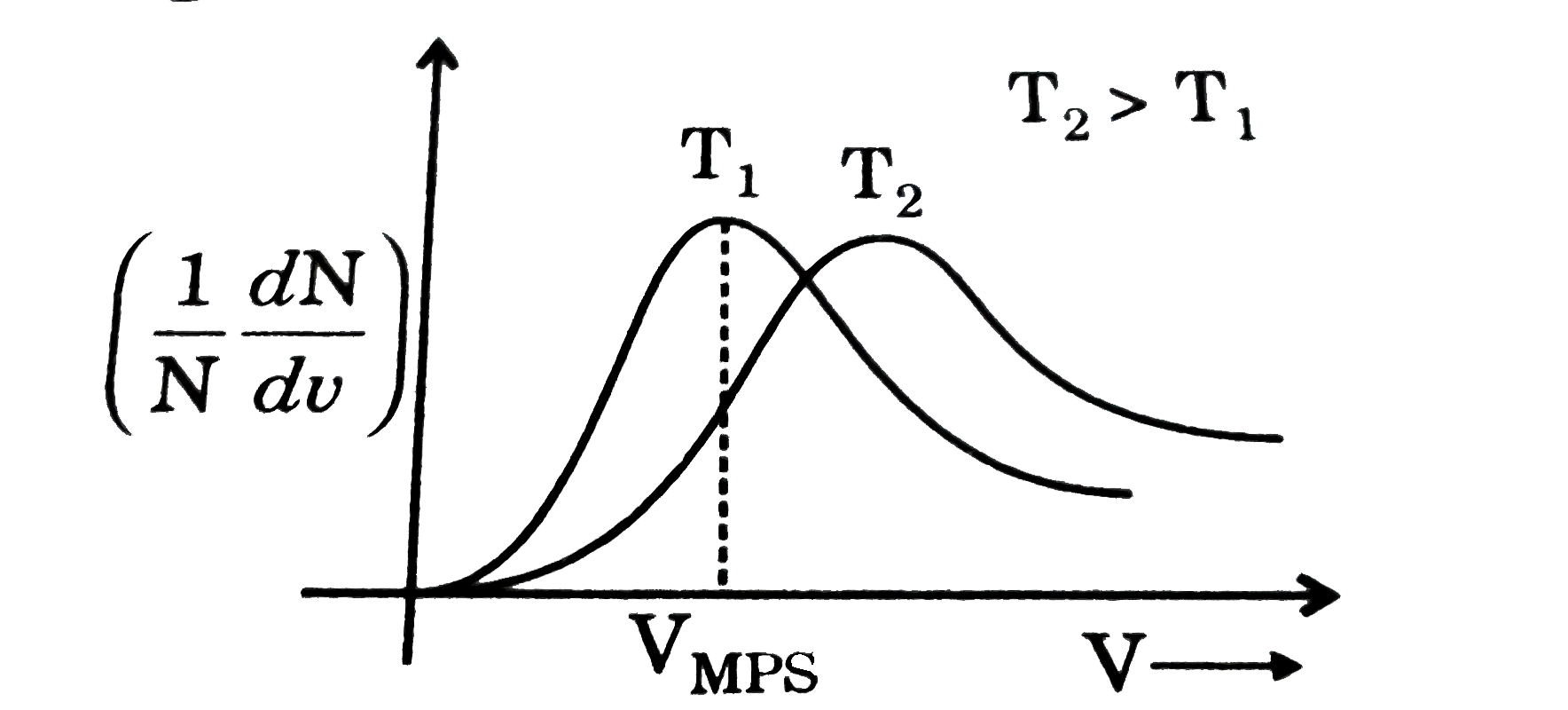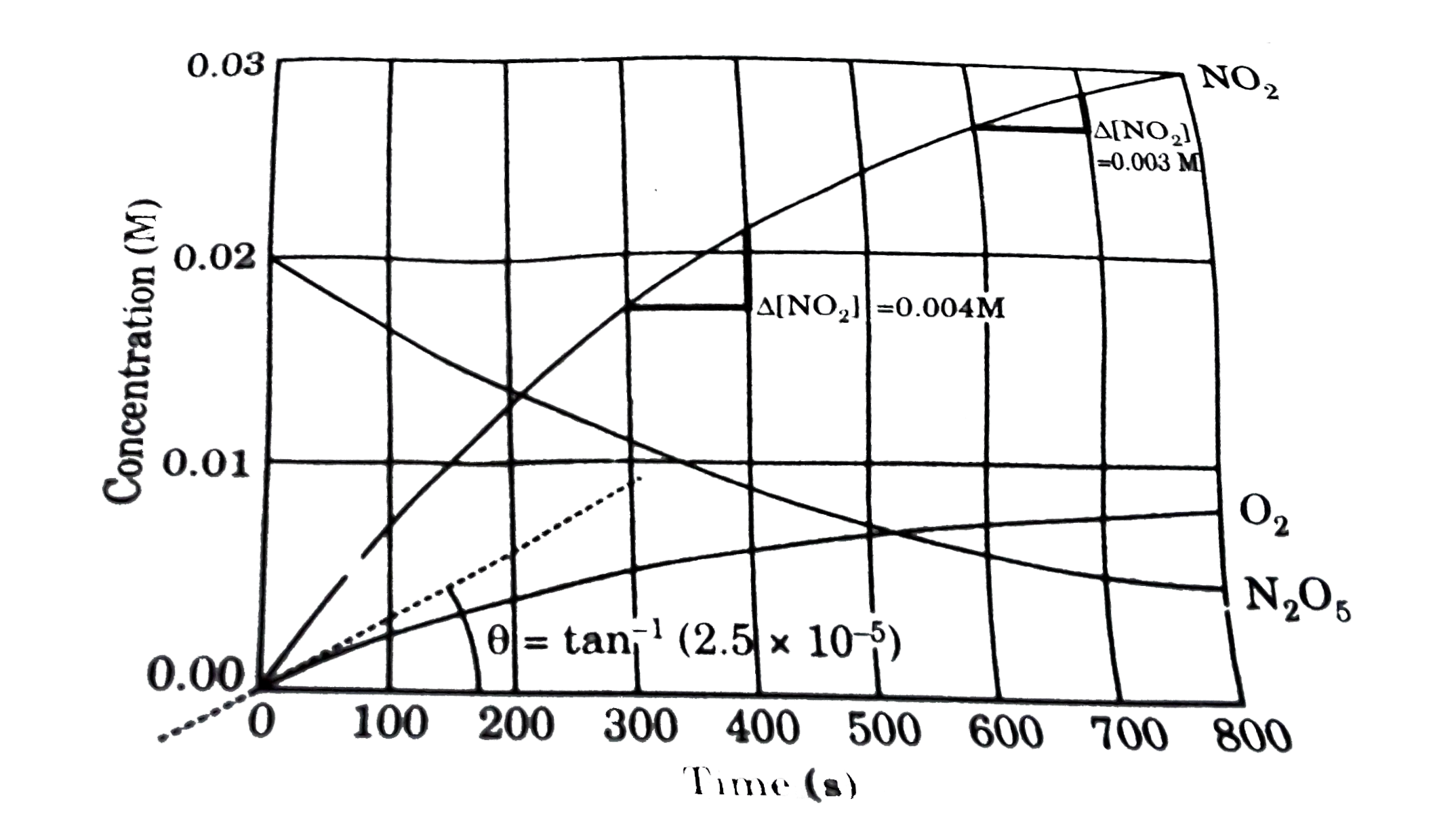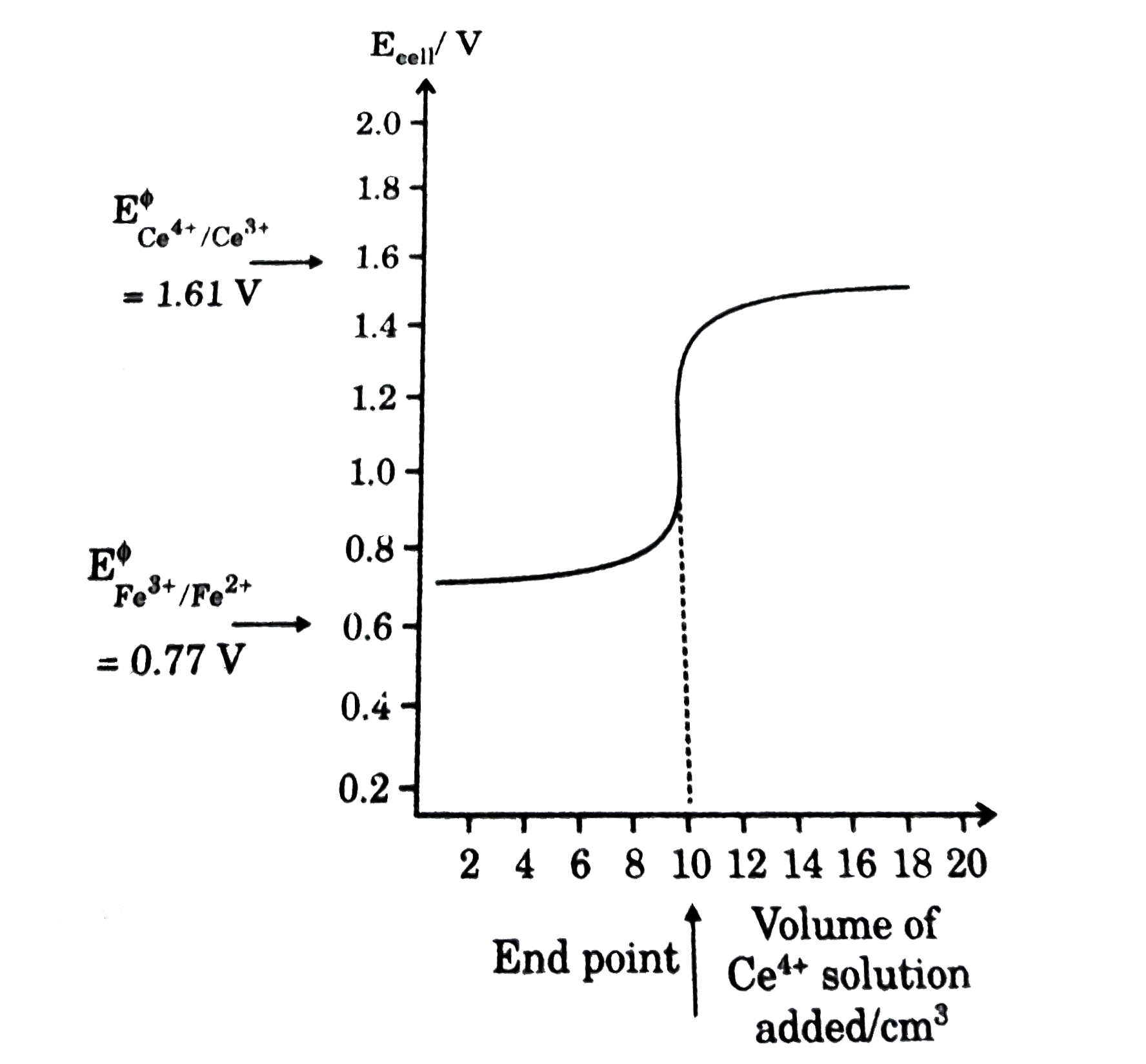The speed of a molecule of a gas changes continuously as a result of collisions with other molecules and with the walls of the container. The speeds of individual molecules therefore change with time.
A direct consequence of the distribution of speeds is that the average kinetric energy is constant for a given temperature.
The average K.E. is defined as
¯¯¯¯¯¯KE=1N(12mΣidNiu21)=12m(ΣidNiN.u21)
where dNN is the fraction of molecules having speeds between ui and ui+du and as proposed by maxwell dNN=4π(m2πKT)3/2exp(−mu22KT).u2.du
The plot of (1NdNdu) is plotted for a particular gas at two different temperature against u as shown.
The majority of molecules have speeds which cluster around vMPS in the middle of the range of v. There area under the curve between any two speeds V1andV2 is the fraction of molecules having speeds betweenV1andV2.
The speed distribution also depends on the mass of the molecules. As the area under the curve is the same (equal to unity) for all gas samples, samples which have the same VMPS will have identical Maxwellian plots. On the basis of the above passage answer the questions that follow.

If a gas sample contains a total of N molecules. The area under any given maxwellian plot is equal ot :
infinite
N
1
N∫0(dNdu).du
The correct Answer is:C
Step by step video, text & image solution for The speed of a molecule of a gas changes continuously as a result of collisions with other molecules and with the walls of the container. The speeds of individual molecules therefore change with time. A direct consequence of the distribution of speeds is that the average kinetric energy is constant for a given temperature. The average K.E. is defined as bar(KE) =1/N((1)/(2)m underset(i)SigmadN_(i)u_(1)^(2)) = 1/2 m(underset(i)Sigma(dN_(i))/(N).u_(1)^(2)) where (dN)/(N) is the fraction of molecules having speeds between u_(i) and u_(i) + du and as proposed by maxwell (dN)/(N) = 4pi ((m)/(2pi KT))^(3//2) exp (-("mu"^(2))/(2KT)).u^(2).du The plot of ((1)/(N) (dN)/(du)) is plotted for a particular gas at two different temperature against u as shown. The majority of molecules have speeds which cluster around "v"_("MPS") in the middle of the range of v. There area under the curve between any two speeds V_(1) "and" V_(2) is the fraction of molecules having speeds betweenV_(1) "and" V_(2). The speed distribution also depends on the mass of the molecules. As the area under the curve is the same (equal to unity) for all gas samples, samples which have the same "V"_("MPS") will have identical Maxwellian plots. On the basis of the above passage answer the questions that follow. If a gas sample contains a total of N molecules. The area under any given maxwellian plot is equal ot : by Chemistry experts to help you in doubts & scoring excellent marks in Class 12 exams.
Updated on:21/07/2023Topper's Solved these Questions
- GRAPHICAL INTERPRETATIONBOOK - GRB PUBLICATIONCHAPTER - GRAPHICAL INTERPRETATIONEXERCISE - Comprehension 13
1 Videos
- GRAPHICAL INTERPRETATIONBOOK - GRB PUBLICATIONCHAPTER - GRAPHICAL INTERPRETATIONEXERCISE - Comprehension 14
1 Videos
- GRAPHICAL INTERPRETATIONBOOK - GRB PUBLICATIONCHAPTER - GRAPHICAL INTERPRETATIONEXERCISE - Comprehension 11
1 Videos
- F-BLOCK ELEMENTSBOOK - GRB PUBLICATIONCHAPTER - F-BLOCK ELEMENTSEXERCISE - Subjective type
7 Videos
- HYDROCARBON (ALIPHATIC)BOOK - GRB PUBLICATIONCHAPTER - HYDROCARBON (ALIPHATIC)EXERCISE - Previous years jee questions
28 Videos
Similar Questions
Concentrations measured as a function of time when gaseous N2O5 at initial concentration of 0.0200M decomposes ot gaseous NO2andO2at50∘C.The change in concentration with time is given by the following graph.

The instantaneous rate of disappearance of N2O5 at the beginning of the reaction is :
View Solution
For the reversible reaction Akf⇐===⇒kbB (having Ist order in both direction) the concentration as a function of time are given for a certain experimantal run.
At what time (t) is the rete of change of concentration A equal to the rate of change of concentration of B in magnitude?
View SolutionTitration are one of the methods we can use to discover the precise concentration of solutions. A typical titration involves adding a solution from a burette to another solution in a flask. The end point of the titration is found by watching a colour change taking place.However, a problem arises when a suitable indicator cannot be found, or when the colour change involved are unclear. In these cases, redox potential may sometimes come to the rescue.

A perticularly well known example (Fig.) is a method of discovering then concentration of iron (II) ions in a solution by titrating them with a solution of cerium (IV). The redox potential that are of interest here areE∘Fe3+∣Fe2+=0.77VandE∘Ce4+∣Ce3+=1.61V. These tell us that cerium (IV) ions are the oxidising agents. They should react according to the equation
Fe2+(aq)+Ce4+(aq)→Fe3+(aq)+Ce3+(aq).
Now imagine that we know the concentration of the cerium (IV) ions solution in the burette. We want to measure the concentration of the cerium (IV) solution from the burette, some of the iron (II) ions are will be oxidised. As a consequence the beaker would now contain large number of unreacted iron (II) ions , but also some iron (III) ions as well. All of the cerium (III). The solution in the beaker now represents an iron (III)/iron(II) half cell although not at standard conditions.Thus , the emf of the cell will be near, but not equal to E∘Fe3+∣Fe2+.

If we continue to add cerium (IV) solution , the number of iron (II) ions is gradually reduced and eventually only a very few are left (Table).At this stage the next few drops of cerium (IV) solution convert all the remaining irom (II) ions into iron (III), and some of the cerium (IV) ions are left unreacted. Once this happens we no longer have an iron (III)/iron(II) half-cell. Instead we have a solution in which there is a large number of cerium (III) ions and a smaller number of cerium (IV) ions. The solution in the beaker now behaves as a cerium (IV)/cerium(III)half-cell (although not a standard one.)
Just before all the iron (II) ions are converted into iron (III) we have a cell with an EMF of around +0.77V. After all the iron (II) ions are oxidised we have a cell with an emf of about +1.61V. This rapid rise in emf occurs with the addition of just one drop of cerium (IV) solution. You should be able to understand why a graph of cell emf against volume of cerium (IV) solution of the iron (II) solution calculated in the usual way.
When an ion is converted into a complex ion, the redox potential change. you can see this in the combination of standard emf of the iron (III)/iron(II) system (+0.36V). The cyanide ion is said to stabilize the oxidation state of the iron. If you were to make up a cell
Pt(s)∣∣ ∣∣Fe(CN)3−61mol dm−1(aq),Fe(CN)4−6∣∣ ∣∣∣∣ ∣∣Fe3+(aq)1mol dm−3,Fe2+(aq)∣∣ ∣∣Pt(s)
what would be the emf and what would be the cell reaction?
View SolutionThe first f-block organometallic compound [ThH(OR)(C5Me5)2] was prepared in late 1970s. Find the oxidation state of central metal atom/cation.
View SolutionWhich of the following will decolourise alkaline KMnO4?
View SolutionDistinguish between average speed and rms speed. If three molecules have speed u_(1), u_(2), u_(3) what will be their average speed and rms speed.
View SolutionThe average speed of an ideal gas molecule at 27^(@)C is 0.3 m, sec^(-1) . The average speed at 927^(@)C
View SolutionIn the previous problem , sphere A is moving with speed u_(1) and sphere B with speed u_(2) in opposite direction. After the collision , sphere A comes to rest , then u_(1)//u_(2) is
View SolutionExpress the average kinetic energy per mole of monostomic gas of molar mass M. at temperature T K in terms of the average speed of the molecules U_("avg") .
View SolutionThe speed of a molecule of a gas changes continuously as a result of collisions with other molecules and with the walls of the container. The speeds of individual molecules therefore change with time. A direct consequence of the distribution of speeds is that the average kinetric energy is constant for a given temperature. The average K.E. is defined as bar(KE) =1/N((1)/(2)m underset(i)SigmadN_(i)u_(1)^(2)) = 1/2 m(underset(i)Sigma(dN_(i))/(N).u_(1)^(2)) where (dN)/(N) is the fraction of molecules having speeds between u_(i) and u_(i) + du and as proposed by maxwell (dN)/(N) = 4pi ((m)/(2pi KT))^(3//2) exp (-("mu"^(2))/(2KT)).u^(2).du The plot of ((1)/(N) (dN)/(du)) is plotted for a particular gas at two different temperature against u as shown. The majority of molecules have speeds which cluster around "v"_("MPS") in the middle of the range of v. There area under the curve between any two speeds V_(1) "and" V_(2) is the fraction of molecules having speeds between V_(1) "and" V_(2). The speed distribution also depends on the mass of the molecules. As the area under the curve is the same (equal to unity) for all gas samples, samples which have the same "V"_("MPS") will have identical Maxwellian plots. On the basis of the above passage answer the questions that follow. For the above graph, drawn for two different samples of gases at two different temperature T_(1) "and" T_(2). Which of the following statements is necessarily true?
View SolutionThe speed of a molecule of a gas changes continuously as a result of collisions with other molecules and with the walls of the container. The speeds of individual molecules therefore change with time. A direct consequence of the distribution of speeds is that the average kinetric energy is constant for a given temperature. The average K.E. is defined as bar(KE) =1/N((1)/(2)m underset(i)SigmadN_(i)u_(1)^(2)) = 1/2 m(underset(i)Sigma(dN_(i))/(N).u_(1)^(2)) where (dN)/(N) is the fraction of molecules having speeds between u_(i) and u_(i) + du and as proposed by maxwell (dN)/(N) = 4pi ((m)/(2pi KT))^(3//2) exp (-("mu"^(2))/(2KT)).u^(2).du The plot of ((1)/(N) (dN)/(du)) is plotted for a particular gas at two different temperature against u as shown. The majority of molecules have speeds which cluster around "v"_("MPS") in the middle of the range of v. There area under the curve between any two speeds V_(1) "and" V_(2) is the fraction of molecules having speeds between V_(1) "and" V_(2). The speed distribution also depends on the mass of the molecules. As the area under the curve is the same (equal to unity) for all gas samples, samples which have the same "V"_("MPS") will have identical Maxwellian plots. On the basis of the above passage answer the questions that follow. If two gases A and B and at temperature T_(A) "and"T_(B) respectivley have identical Maxwellian plots then which of the following statement are true?
View SolutionAt 27^(@)C a gas contains 10 molecules travelling with a speed of 4 ms^(-1) , 20 molecules travelling with a speed of 5 m s^(-1) and 40 molecules travelling with a speed of 8 m s^(-1) . Calculate the average speed, root mean square speed and most probable speed of the gas at 27^(@)C .
View SolutionIf u_(1), u_(2), u (3) "…..." represent the speed of n_(1), n_(2) , n_(3) ,"…..." molecules , then the root mean square speed is "____________" .
View SolutionThe function un takes on the following values :
u1=14,u2=14+110….....
un=13+1+132+1+….........13n+1….........
Prove that limn→∞ua<12
View SolutionThe function un attains the values
u1=12,u2=12+12.4+12.4.6
un=12+12.4+....12.4....(2n),............
Prove that limn→∞un<2
View Solution
